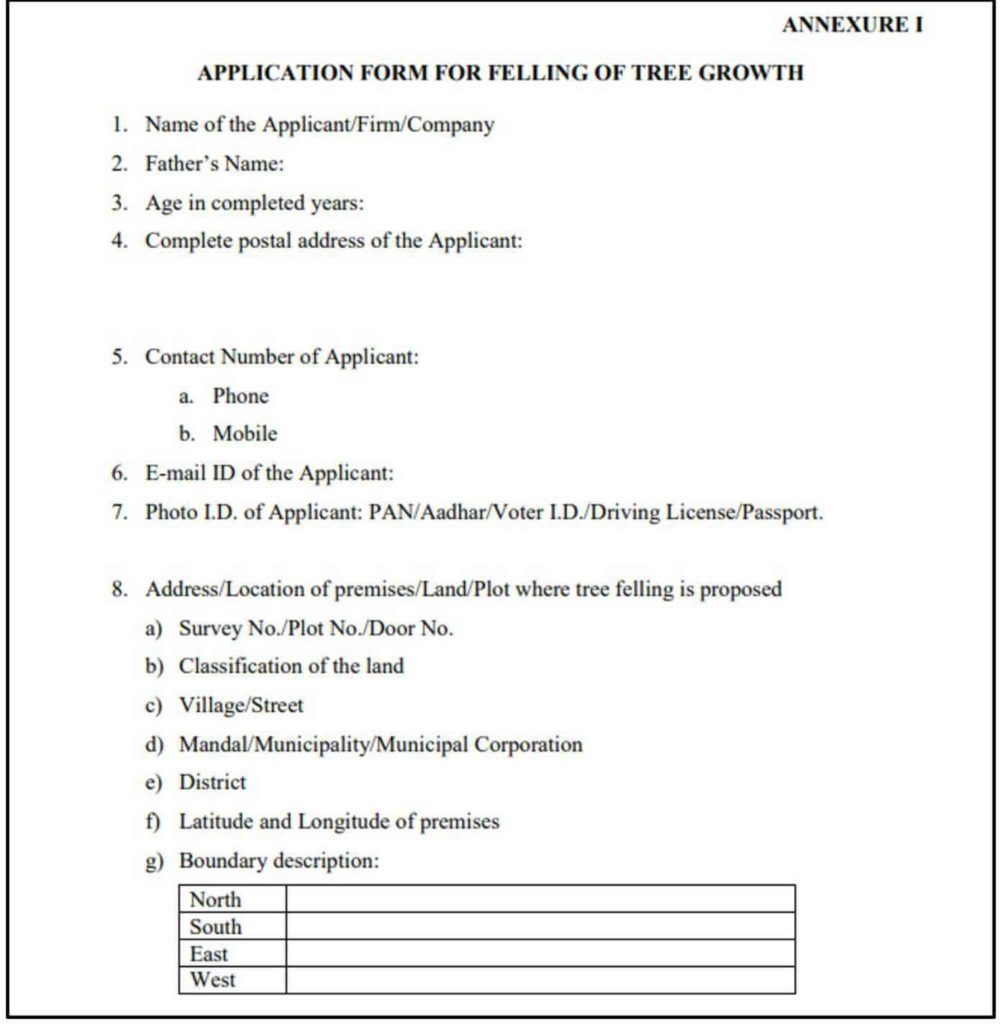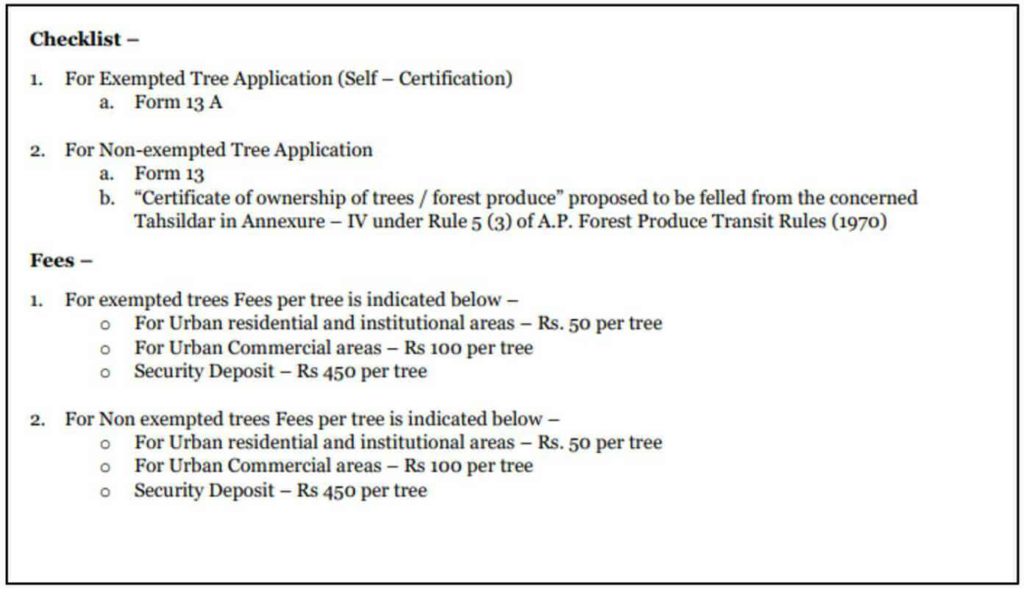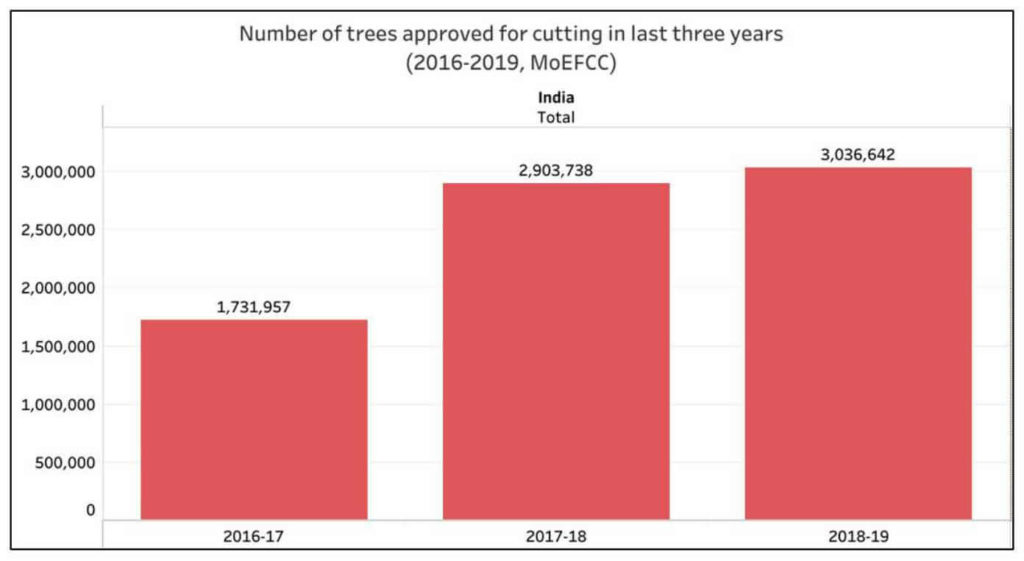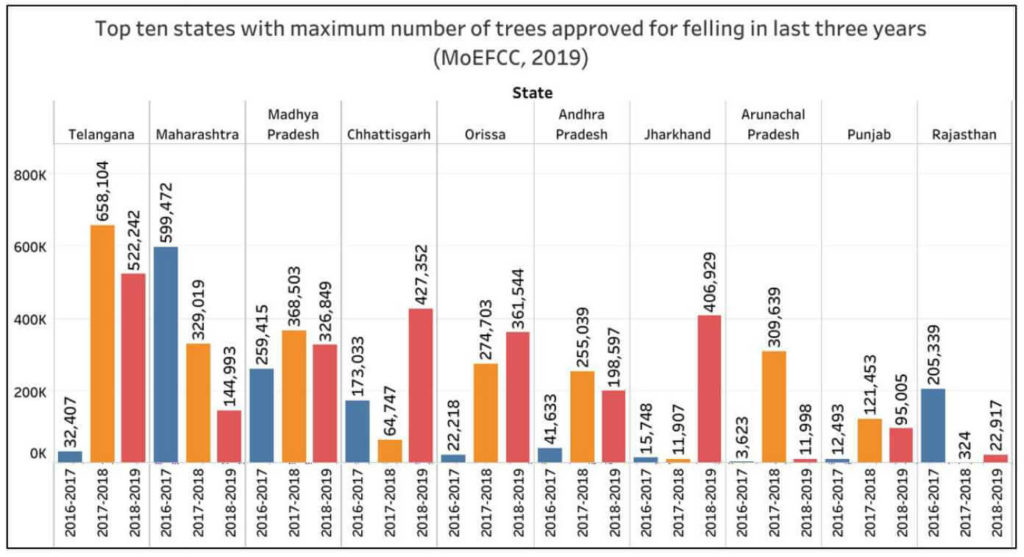The protests in Mumbai against tree felling in the Aarey forest put the focus on tree felling across the country. As per the available data, governments permitted felling of more than 1 crore trees between 2014 & 2019 under the Forest Conservation Act. Though data is not available, many more trees would have been cut under various state laws.
Last year, there were intense protests in Mumbai when the Maharashtra government permitted Mumbai Metro Rail Corporation to clear trees in Aarey forest for the construction of metro railcar shed. Ultimately, the Supreme Court had to intervene and stayed the felling of trees. This particular incident put the focus tree felling and the trends across the country.
As per data shared by the government in the Lok Sabha, between 2016 and 2019, permission was sought for felling more than 76 lakh trees under the Forest Conservation Act (FCA). Telangana topped this list with permissions for felling 12.12 lakh trees in these 3 years. Another set of data shared by the government indicates that permission was sought for felling more than 1 crore trees between 2014 & 2019. However, it has to be noted that these are only numbers where the permission was sought under the Forest Conservation Act (FCA). Data for trees felled under various state laws are not maintained centrally though many more trees would have been felled under various state laws.
Who approves tree felling?
The approval for tree felling depends on the type of area (place/land) and also the type of trees. For any diversion of forest land to non-forest activities which involves tree cutting, the approvals are granted as per the provisions laid down in the Forest Conservation Act (FCA). In the case of tree cutting in non-forest & private lands, the process laid down in relevant state laws is to be followed.
Some examples of state laws are Maharashtra Felling of Trees (Regulation) Act, 1964, Punjab Land Preservation Act, 1900, Telangana Water, Land and Trees Act (WALTA), The Tamil Nadu Preservation of Private Forest act.
FCA mandates approval from government for forest clearance
Under the Forest (Conservation) Act, it is mandatory to get clearance from the government before diverting forest land for non-forest purpose. For this, the project proposal has to be sent to the nodal officer of state government as per Forest Conservation Rules of 2003 following which examination of the proposal takes place at various levels.
The approval process for trees in non-forest areas varies based on tree type
In the case of non-forests and other private lands, the process laid down in the relevant state law is followed. In most state laws, trees are categorized into exempt & non-exempt categories. The process is differently defined for both these categories.
In most states like Tamil Nadu, Maharashtra, Gujarat, Andhra Pradesh, Telangana the application process for felling of trees has been simplified following the introduction of the Ease of Doing Business (EoDB) rankings.
In the case of Telangana, those who want to fell trees in Patta land or government assigned land for the industry have to submit an online application with details related to land, its ownership, tree species, number of trees and dimensions along with required documents.
A list of exempted and non-exempted species of trees based on its value is maintained by the department. In the case of exempted trees, the applicant can pay the fee and then go ahead with felling, which is called the self-certification process. The procedure for non-exempted trees is more elaborate as discussed below.
In the case of non-exempted trees, the application has to be filed along with the relevant annexures.

The application goes to the Forest Divisional Officer. It is then forwarded to Forest Range Officer who, along with Forest Section Officer inspects the site. The DFO/designated officer then issues notice asking the applicant to pay a security deposit as an assurance of replanting the area. The process along with timelines at each stage is defined.

The amount to be paid per tree also varies based on the category in which the tree falls.

Data shared in the Lok Sabha only pertains to FCA
The data shared in the Lok Sabha recently only pertains to permission sought for removal of trees (tree felling) under the FCA. Permissions sought for tree felling as per the state laws could be many more and such data is not maintained centrally.
More than 76 lakh trees were felled between 2016-17 & 2018-19 under provisions of FCA
In the last three years, between 2016-17 & 2018-19, more than 76.72 lakh trees were cut under the Forest (Conservation) Act, 1980. About 40% of these permissions were given in 2018-19 alone.
It is observed that the number of trees cleared for ‘developmental’ activities has increased by 40% in 2017-18 and by another 4.5% in 2018-19.

Telangana tops the list with 16% of the tree felling under FCA
State-wise analysis reveals that Telangana accounted for the maximum number of tree felling permissions in these three years. A total of 15.8% of the permissions were in Telangana. In fact, the state also accounted for the maximum number of trees felling permissions in both 2017-18 and 2018-19.
Following Telangana is Maharashtra which accounted for 14% of the permissions in the three years. In 2016-17, Maharashtra reported the maximum number of tree felling permissions with these accounting for 56% of the permissions in Maharashtra in the three years.
Ten states account for more than 80% of the tree felling permissions under FCA
Almost 82% of the total felling permissions under FCA, between 2016-17 & 2018-19 were reported from only ten states. In addition to Telangana & Maharashtra, the list also includes Madhya Pradesh, Chhattisgarh, Odisha, Andhra Pradesh, Jharkhand, Arunachal Pradesh, Punjab and Rajasthan.
While Sikkim, Goa, Delhi and Tamil Nadu reported less than 10,000 tree felling permissions in the three years, Mizoram, Kerala, Tripura and Meghalaya were the only states which reported a total of less than 1000 tree felling permissions each in this period.

In Assam and Jharkhand, more than 90% trees felled in the three years was in 2018-19
The massive increase in the proportion of trees felled in 2018-19 under FCA is because of a few states which showed a substantial increase from thousands to lakhs in 2018-19. These states are- Chhattisgarh, Odisha, Jharkhand, Haryana, Himachal Pradesh and Assam. During these three years, 99% of the trees felling permissions in Assam and 94% in Jharkhand were reported in 2018-19. Similarly, around 63% of tree felling permissions in Haryana, Chhattisgarh and Himachal Pradesh, and 55% in Odisha were also reported in the same year.
Data from previous Lok Sabha session shows different numbers
Strangely, the data provided in the Lok Sabha in July 2019 regarding the number of tree felling permissions in the last five years show different numbers. Between 2016-17 and 2018-19, the increasing trend is visible in spite of different numbers presented.

Government claims that action is being taken to increase India’s forest cover
The government has tried to compensate this loss by highlighting the increase in forest cover and tree cover as per the latest 2019 Forest Survey of India’s State of Forest report. Since 2015, as per this report, tree and forest cover have increased by 13,209 sq.km. The forest cover includes all land in the country which has trees on more than one-hectare land area irrespective of ownership or legal status. Similarly, tree cover includes all tree patches of less than one hectare outside the recorded forest area.
Furthermore, the ministry also stated that 7.87 crore trees were stipulated to be planted in place of the 76.72 lakh trees removed under compensatory afforestation. The government runs the Compensatory Afforestation Programmes, National Afforestation Programme and Green India Mission, but the impact of these programs is to be studied in detail. The biodiversity loss that results from the chopping down of trees cannot be compensated in the short-term.
Featured Image:Forest Conservation Act


